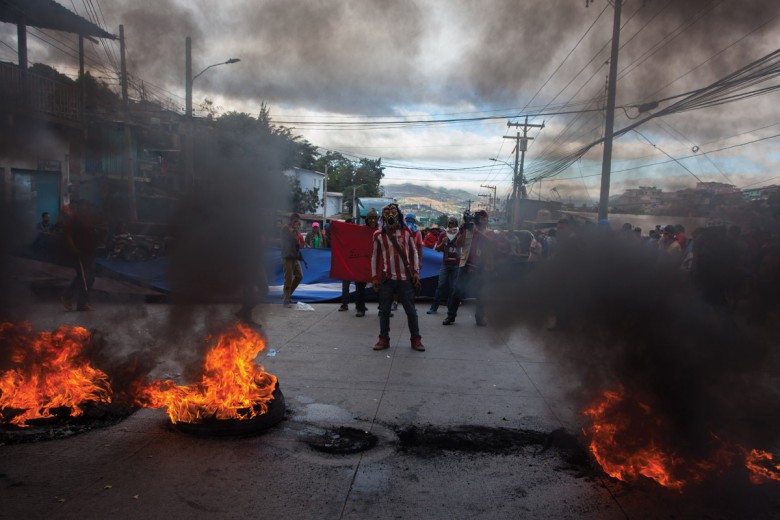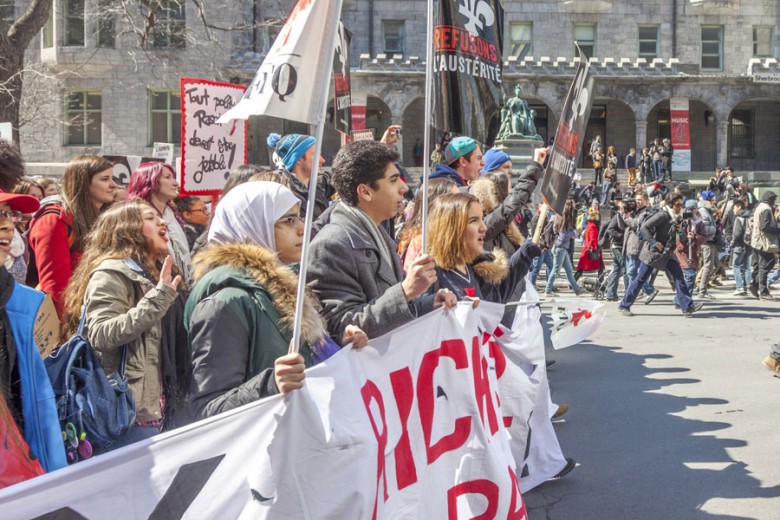
December 2009’s Copenhagen climate summit fell far short of expectations. Explanations for the failure to reach a legally binding, fair and ambitious agreement to reduce global greenhouse gas emissions are legion but, in the end, the summit produced little more than the hastily negotiated Copenhagen Accord, a face-saving effort that does not commit nations to any binding emission reduction targets.
The accord does, however, call for the increase in average global temperatures to be limited to two degrees celcius (2 C) above pre-industrial levels. Many scientists believe that beyond this point, we may cross a climate threshold into potentially catastrophic and unmanageable runaway warming.
Achieving this objective is another matter and the path forward is plagued by uncertainty.
Since Copenhagen, 55 nations (including Canada) representing some 80 per cent of humanity’s annual greenhouse gas contributions have made voluntary commitments to reduce their emissions. Sounds promising — except for a couple of nagging details. First, even if fulfilled, these commitments added together leave the world heading for warming of over 3 C above pre-industrial levels by 2100.
Due mainly to fossil fuel emissions, we’ve already witnessed a temperature increase of 0.8 C during the 20th century. That leaves us just 1.2 degrees of wiggle room to remain within the 2 C limit endorsed in Copenhagen.
Second, many feel that the 2 C target is itself simply too high. An average global increase of 2 C means some regions in the developing south — much of Africa, for instance — will be subject to a 3.5 C or even 4 C increase. This, as Archbishop Desmond Tutu of South Africa has said, “is to condemn Africa to incineration and no modern development.” Many in the climate change struggle strongly believe that warming must instead be limited to a maximum of 1.5 C globally.
Finally, according to the 2007 synthesis report of the Intergovernmental Panel on Climate Change (IPCC), limiting warming to 2 C will require that the atmospheric concentration of carbon not exceed 450 parts per million at the very most. From the pre-industrial level of 280 ppm, we are now sitting at a precarious 390 ppm and rising fast. If we accept the 450 ppm limit, that leaves us a meagre 60 ppm to work with. Sixty ppm for all of humanity to share, including China, India and the rest of the Global South whose economies, fuelled by carbon-intensive energy, are growing at rapacious speeds.
It is safe to bet that these countries will not be content to fight over the atmospheric table scraps that now remain. Indeed, the battle for the atmosphere is shaping up to be the geopolitical struggle of the 21st century, dividing North from South, high emitters from low, industrialized nations from industrializing. And if recent developments are any indication, Canada is readying itself for one dirty fight.Canada as climate pariah
Canada’s Conservative government has long maintained that full participation by both Global North and South in cutting greenhouse gases is necessary to tackle global warming.
In 2007, Prime Minister Harper blocked a consensus among 50 Commonwealth countries to endorse binding commitments by industrialized countries to reduce greenhouse gas emissions, noting that the declaration did not include developing countries. “Canada’s view is that we need binding targets on all nations” Harper stated at last November’s Commonwealth Heads of Government meeting in Trinidad and Tobago. The government then proceeded to push for a new paragraph in the Commonwealth’s statement that called for further negotiations on climate change to be done “individually and collectively” and to “have respect for different national circumstances.”
This position, when viewed in combination with the frenzied development of Alberta’s highly polluting tar sands and with Canada’s abysmal record in living up to our past greenhouse gas reduction commitments, has made Canada a pariah of the climate change movement. Our country’s total emissions are now 34 per cent above our Kyoto targets and our per capita emissions are among the world’s highest. Prominent campaigners, politicians and scientists have even called for Canada’s suspension from the Commonwealth over its climate policies and failure to take meaningful action. “Stephen Harper’s position is that there is no history — we all start at zero from today” journalist and author Gwynne Dyer told Briarpatch. As a result, Canada is now seen by many countries “basically as a climate change rogue state” he says. In December of last year, George Monbiot, columnist for the Guardian and climate change activist, wrote that Canada had become so obstructionist on international efforts to combat climate change that our fair country “now threatens the well-being of the world.”
The Canadian government has responded to these criticisms with a predictable refrain: Canada is a small player, contributing only 2 per cent to global emissions and, as Stephen Harper stated at last year’s APEC meeting, if emissions from emerging economies are not controlled, “whatever we do in the developed world will have no impact on climate change.” Moreover, the government says, countries and companies that are not subject to reduction targets may gain a competitive advantage over those that do face regulations.
It’s a persuasive argument and many Canadian media commentators (not to mention the general public) have swallowed it whole. But there is a problem. To accept this line of reasoning is to ignore the crucial historical context behind the climate crisis and to overlook one indisputable fact: the unsustainably high levels of carbon currently in the atmosphere are almost entirely the work of industrialized countries. In our fossil-fuelled development, the Global North has emitted roughly 75 per cent of total historical greenhouse gas emissions.
By asking poorer countries to bind themselves to diminishing emissions budgets before the rich have set their own targets, Canada is contributing to perhaps the single biggest impediment to progress in international climate negotiations.
For developing countries, acquiescing to such a demand would be “like jumping out of a plane and being assured that you are going to get a parachute on the way down” as Yvo De Boer, the Executive Secretary of the UN climate negotiations, said just prior to Copenhagen.
Some have gone even further in their condemnation of Canada’s position. “The attempts by northern commentators to lay blame on some countries for derailing the result (in Copenhagen) … are seen in most developing countries as further evidence of an essentially colonial outlook” Indian economist and columnist Jayati Ghosh told Briarpatch. “Colonialism was all about appropriating global resources — and climate change is really no different. With their emissions, developed countries are currently consuming much of the world’s resources and saying, “˜we did it in the past and now that we’re used to our standard of living, we’re going to continue to do it and we will prevent you from trying to have more for yourself.’”Strong words indeed. But are Canada’s climate change policies really tantamount to neo-colonialism? Let’s take a closer look.
What is Canada’s fair share?
Very few would deny the fact that southern countries will have to rein in their carbon emissions if we are to have any chance of solving the climate crisis. After all, emerging economies now contribute close to half of all global emissions and that proportion will rise to two-thirds in the future.
But given the unequal emissions history and the fact that per capita emissions are still vastly higher in the Global North (even in China per capita emissions are still only one-quarter of Canada’s), how much can the South reasonably be expected to contribute?
We’ve seen that we are a mere 60 parts per million shy of the crucial 450 ppm atmospheric carbon threshold. To translate this into actual emissions, a recent study published in the journal Nature calculated that humanity can afford to put no more than one trillion metric tons of CO2 in the atmosphere between 2000 and 2050. This is in addition to the 1.2 trillion tonnes we (mostly northern countries) emitted prior to 2000. Because CO2 remains in the atmosphere for 50-200 years on average, one of the authors of the study, Myles Allen of Oxford University, said that what is important is the total emissions that have accumulated since the start of the industrial revolution. “To avoid dangerous climate change we will have to limit the total amount of carbon … not just the emission rate in any given year.”
One trillion tonnes. Sounds like plenty. Trouble is, more than a third of that amount was emitted globally from 2000-2009 and we still have 40 years to go.
That leaves only 650 billion tonnes for poor countries — 80 per cent of the world’s population — to share if emissions from the Global North stops immediately. Obviously, they won’t. Rich nations, after already benefitting enormously from unchecked emissions in the past, are now fighting for a bigger piece of the world’s remaining carbon budget as well.
Consider Canada’s emissions. The Canadian government’s most recent goal is to reduce emissions to 17 per cent below 2005 levels by 2020, making it one of the least ambitious targets of all industrialized countries. Setting aside the fact that the government has yet to issue any convincing plan on how it intends to meet this objective given the explosion of emissions from Alberta’s tar sands, let’s assume for the sake of argument that they succeed.
Based on Environment Canada’s own figures from 2007, we can estimate that total emissions from 2001-2020 will average at least 700 million metric tonnes per year (they will almost certainly be higher). That means that more than 14 billion metric tonnes will be emitted in Canada over this 20-year period.
Of the available 650 billion tonnes of total atmospheric space remaining until 2050, Canada, with just 0.5 per cent of the world’s population, plans to take at least another two per cent of the remaining global carbon budget by 2020. How much more carbon we will emit by 2050 is anyone’s guess.
And remember, this is to reach the 450 ppm (or 2 C increase) target. If we are to limit warming to 1.5 C, as many feel is imperative, the global target would then be 350 ppm. This would shrink the available atmospheric space considerably and make Canada’s share of the remaining carbon budget even more disproportionate.
Who then should sacrifice their emissions for the sake of Canada’s continued atmospheric expansion plans? Carbon intensive energy has driven our economy and made us rich, but if 2 C is the limit (and Canada has agreed to this), will we now deny these same benefits to those living in poverty in the Global South?
Of course, due to economic inertia, most of Canada’s emissions in the next few years simply can’t be avoided at this stage. But where does this leave southern countries? Quite simply, with almost no room left to expand.
If countries like Canada are unwilling to make deep cuts quickly, it’s very difficult for poor countries to see how they can reconcile their development aspirations to the atmospheric limits of climate stabilization at 2 C of warming. As Jayati Ghosh wrote in the Guardian, “even without trying to replicate western standards of living, just to provide every citizen with minimum decent standards that contemporary technology can offer, such as permanent housing, electrification, access to clean water, sanitation and sufficient food, will necessarily require more resource use and result in more carbon emissions.”
And so begins the battle for the atmosphere.
Climate justice
The historical legacy of inequitable resource appropriation by rich countries is deeply felt in the developing world. In his landmark 1971 book Open Veins of Latin America, Eduardo Galeano wrote, “The strength of the imperialist system as a whole rests on the necessary inequality of its parts” The oppressor countries get steadily richer in absolute terms — and much more so in relative terms — through the dynamic of growing disparity.” For many in the Global South, the atmosphere is simply another resource that the North is seeking to appropriate disproportionately through international climate negotiations.
Partly in response to the position of some northern countries such as Canada, a climate justice movement has started to emerge around the world. Those involved believe that climate change cannot be separated from issues of equity, justice and the need for development. They refuse to accept the choice between developmental justice and climate stabilization and they insist that the Global North, through its past emissions, owes an ecological debt to the South.
Predictably, the call for reparations has been dismissed by governments in rich countries. Todd Stern, the chief U.S. negotiator in Copenhagen, said, “For most of the 200 years since the Industrial Revolution, people were blissfully ignorant of the fact that emissions caused a greenhouse effect.”
But if our past actions could result in grievous harm to others, whether through wilful negligence or otherwise, do we not have a profound moral obligation to act quickly to alleviate potential suffering? Moreover, we have known about global warming for over 20 years now, yet developed countries are still doing very little to reduce emissions and make atmospheric space available for other nations.
Responding to Stern’s remarks, renowned Indian environmental leader and feminist Vandana Shiva said, “I think it is time for the United States to stop seeing itself as a donor and recognizing itself as a polluter, a polluter who must pay for its pollution and its ecological debt. This is not about charity. This is about justice.”
North American media have for the most part utterly failed to recognize the ethical dimensions of climate change, and consequently most Canadians see little problem with judging our government’s climate change policies solely on the basis of our national economic interest. As a result, ethics and justice are the crucial missing ingredients in our national conversation about climate change. Gwynne Dyer put it this way: “The reason no deal was possible [in Copenhagen] is that public opinion in the Global North is still in denial about the fact that the final deal must be asymmetrical. It’s got to accept and account for the history. Until the general public grasps that, especially in the United States, there will be no real progress.”
The reason for this impasse is quite simple. Today, the only proven routes out of poverty still involve an expanded use of energy and, consequently, a seemingly inevitable increase in fossil fuel use and carbon emissions — unless more expensive alternative energies can rapidly be deployed.
Only when the North has committed to deep cuts and put sufficient money on the table, can we justifiably expect the South to commit to binding reductions of their own. As one climate change adviser to the Indian government noted, “The basic concern of the developing countries is not whether or not to initiate mitigation actions, but how the mitigation burdens will be distributed among nations.”
The Harper government surely knows that its demands of developing countries cannot be accepted and will only serve to further delay any meaningful global action. “Western nations are engaged in a lose-lose game of chicken with developing nations” writes author Naomi Klein in Rolling Stone. And in the meantime, Canada’s emissions will continue to rise. The government’s ballyhooed Clean Air Regulatory Framework from 2007 still has not been implemented and the recent federal budget contained no new funding whatsoever for climate change mitigation.
Poverty alleviation and equitable forms of development are possible within the world’s small remaining carbon budget with existing clean energy technologies. But this will only become a reality if rich nations like Canada are willing to accept their historical responsibilities by implementing stringent domestic reductions that will free up atmospheric space for the rest of the world, and by paying developing countries to leapfrog fossil fuels and make the transition directly to cleaner energy.
Tragically, our current government has shown no such inclination. With the world sliding towards 2 C of warming and potentially catastrophic climate change, Canada seems quite content to simply fight for whatever atmospheric space remains.






